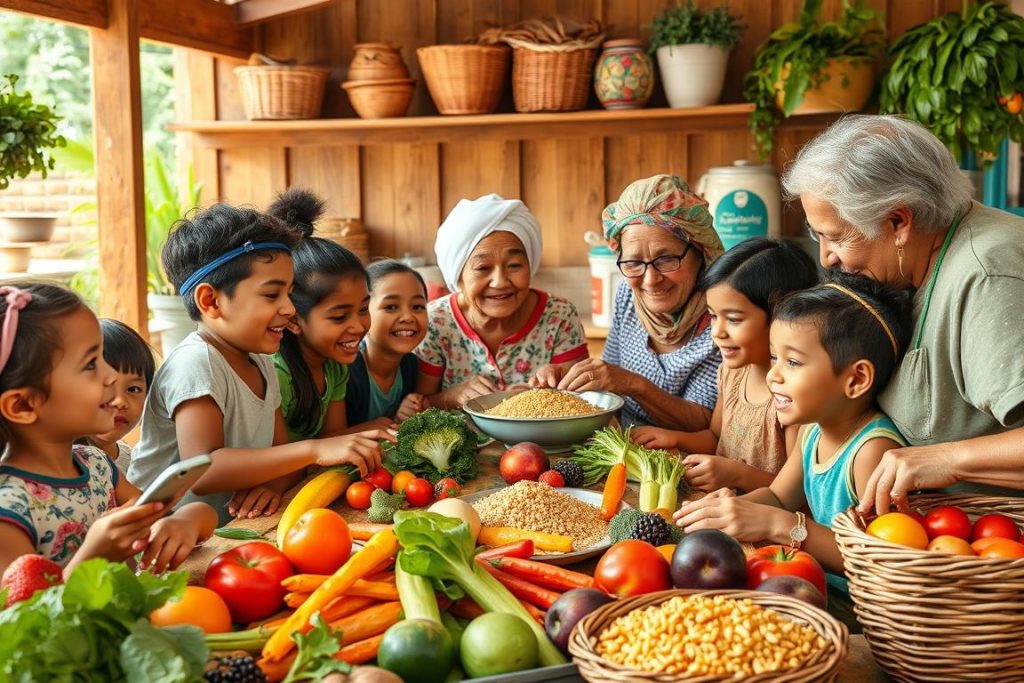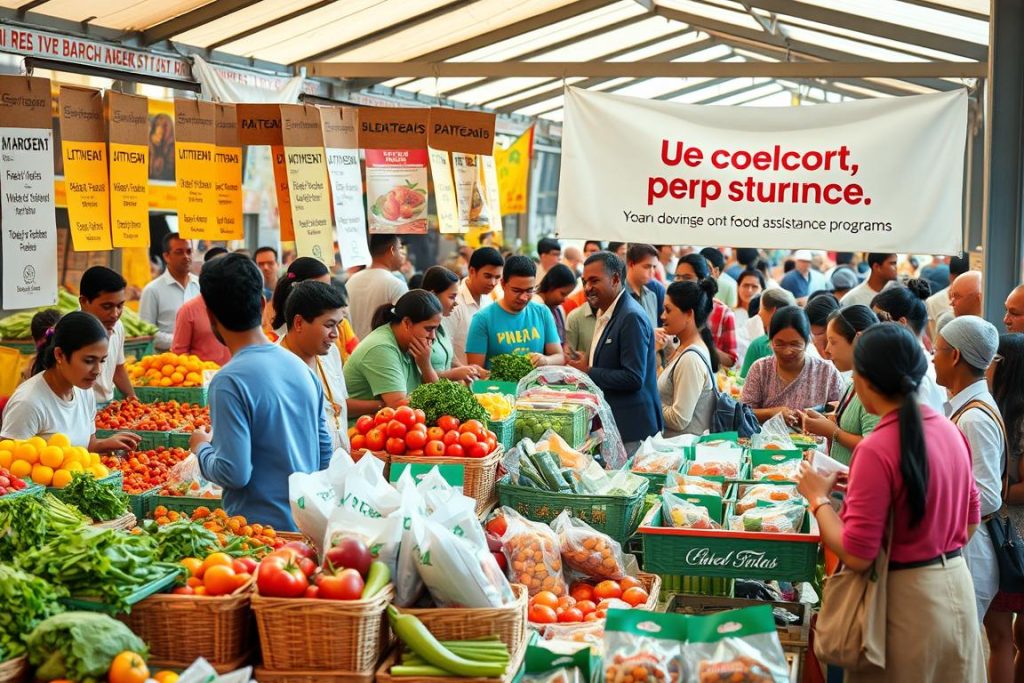In every community, there’s a need we all share: the need to eat and have enough food. Yet, many Americans struggle to meet this basic need due to tough economic times. They often worry about how they’ll get their next meal. Government food assistance programs like food stamps and emergency food help are here to support. They are especially crucial for older adults who may have less income and more challenges.
Many initiatives, such as Meals on Wheels, food banks, and SNAP, are available to make sure everyone has enough to eat. These options are like a ray of hope for those finding it hard to get by, especially seniors. They offer nutritious food to those who need it most.
Key Takeaways
- Explore the variety of government food assistance options available to help you sustain a healthy diet.
- Understand the eligibility criteria and how to access programs like SNAP and Meals on Wheels.
- Learn about senior-specific aid with food banks and senior food boxes.
- Recognize the impact of food assistance on both individual well-being and broader economic activity.
- Discover the importance of utilizing available resources to maintain nutritional security.
Whether an older person benefits from a program that delivers food to their home1, or a child gets a healthy snack from an Afterschool Meal Program2, these programs fill an important need. They help close the gap between needing food and getting it. Begin your path to food security today and improve your family’s health. Food assistance programs are just a click away. Find out how to get food help now.
Understanding Government Food Assistance Programs
Many Americans rely on government food assistance programs for important nutrition support. There are different programs designed to meet the needs of various people.
Supplemental Nutrition Assistance Program (SNAP)
SNAP, also known as the food stamp program, is key in fighting hunger. In 2023, it helped about 42 million people each month, showing its huge role3. Despite some wrong ideas, SNAP greatly reduces hunger, especially when the economy is bad, like during the Great Recession4.
Women, Infants, and Children (WIC)
WIC helps low-income women, infants, and children under five with food, healthcare tips, and nutrition advice. It’s very important for a child’s health and early growth, giving them a healthy start.
National School Lunch Program and School Breakfast Program
These programs are more than just food; they offer steady nutrition to many students. Providing healthy meals at school is key for their growth and helps them focus and do better in their studies.
The Emergency Food Assistance Program (TEFAP)
TEFAP provides emergency food help for free to low-income people. It helps those in sudden need get the nutrition they require.
Understanding these assistance programs shows why it’s important they get enough support and money. Better SNAP funding leads to healthier lives and can lower child poverty4. With SNAP giving about $1.40 per meal, it’s clear these programs are essential and help millions avoid hunger4.
Specialized Food Programs for Children and Seniors
Finding food help can be tough, especially for kids and older people. The U.S. has special plans to help these groups get the right food. These plans help through emergency food help, food banks, and pantry support.

Child Nutrition Programs for School-Aged Children
Child Nutrition Programs give vital food to kids in school. This helps them learn and grow. The USDA’s summer meal plans give free nutritious meals to kids under 18 during school breaks5.
These efforts are key in fighting kid hunger. They make sure kids get the nutrients they need for their bodies and minds.
Food Distribution Programs on Indian Reservations
The FDPIR gives food to low-income Native American families and elders. It’s an option besides the well-known SNAP, offering direct food aid in tribal areas. This makes getting food easier for those living on reservations.
Nutrition Programs for Seniors
For older adults, staying nourished can be hard. That’s where Meals on Wheels comes in. This program delivers meals to people generally 60 and older at their homes5. Besides meals, the Senior Nutrition Program gives nutrition checks, advice, and counseling. This can happen in groups or at home, helping older people stay healthy and active6.
Understanding and using these food programs can greatly improve the lives of kids and seniors. By giving them access to the right food, these programs work towards a healthier future for vulnerable groups.
Food Assistance Programs for Diverse Needs
The United States offers a variety of food assistance programs. These programs help many people, from those with little money to those in a temporary tight spot. CalFresh and other benefits not only give immediate food help but also focus on making sure people eat healthily for the long term. Over 46 million Americans use the Supplemental Nutrition Assistance Program (SNAP), making it the biggest food aid program7. Other specific programs, like WIC, help pregnant women, new moms, infants, and children get the important nutrients they need7.
Snap offers extra perks to encourage eating more fruits, vegetables, and whole grains. People get coupons and discounts when they buy healthy foods with their SNAP EBT card8. These efforts not only help improve what people eat but also boost local food sellers by getting people to shop at participating places.
| Program Type | Key Benefits | Funded By |
|---|---|---|
| Federally Funded SNAP Incentives | Increased fruit and vegetable consumption | Federal Government |
| State/Local Government Funded | Extended discounts on healthy foods | State or Local Government |
| Privately Funded Programs | Enhanced economic impacts at local level | Private Entities |
Food banks and food pantry assistance are key in providing quick food help. They are crucial community pillars, especially during hard times or economic drops. These places often team up with government programs and local shops to help more people.

For folks like the elderly who can’t get around easily, there’s a Home-Delivered Nutrition Program. This program delivers meals right to people’s homes. It’s a great example of how these programs change to help the community’s different needs, improving food access for those in need8.
In summary, the United States has strong and flexible food aid programs. Whether it’s through special offers to buy healthy food or direct food help from food banks, these programs aim to meet the nutritional needs of all different kinds of people effectively.
Conclusion
The work of government agencies in helping with food needs shows our nation’s commitment to solving food insecurity. Statistics from the USDA in 2015 show that hunger has increased since before the economic downturn. Despite this, programs like SNAP have helped keep hunger from rising even more9. Think about how SNAP and other recommendations could help your family live a healthy and stable life9.
It costs a lot to fight hunger – over $75 billion in 2011 for SNAP to help more than 46 million Americans10. If your income is low enough, SNAP can be a lifeline, helping you buy healthy food based on the Thrifty Food Plan10. CalFresh is adjusting to meet community needs and focus on improving 10 areas of the SNAP program9.
Looking for help from these programs is a strong move towards having enough food. These programs offer help to many, especially homes with elderly or disabled people. This network of assistance is designed to get people back on their feet, as Commissioner Mayhew said, by aiding nondisabled, working-age adults to overcome poverty9.
FAQ
Supplemental Nutrition Assistance Program (SNAP)
Women, Infants, and Children (WIC)
National School Lunch Program and School Breakfast Program
The Emergency Food Assistance Program (TEFAP)
Child Nutrition Programs for School-Aged Children
Food Distribution Programs on Indian Reservations
Nutrition Programs for Seniors
How can SNAP benefits help me?
Am I eligible for WIC and what does it offer?
Can senior citizens receive food assistance?
Are there food assistance options for students?
How do food banks and food pantries assist in emergency situations?
What is TEFAP and who does it serve?
How can I apply for food assistance programs like SNAP or WIC?
Source Links
- 6 Benefits That Could Help Older Adults Pay For Food – https://www.ncoa.org/article/6-benefits-that-could-help-older-adults-pay-for-food/
- LA County Department of Public Health – http://lapublichealth.org/nut/food_assistance_programs.htm
- What is SNAP? An Overview of the Largest Federal Anti-Hunger Program – https://www.pgpf.org/blog/2024/09/what-is-snap
- Links of the Supplemental Nutrition Assistance Program With Food Insecurity, Poverty, and Health: Evidence and Potential – https://pmc.ncbi.nlm.nih.gov/articles/PMC6836787/
- Food Assistance and Food System Resources – https://www.cdc.gov/nutrition/php/resources/food-and-food-system-resources.html
- Nutrition Assistance Programs – https://www.ssa.gov/pubs/EN-05-10100.pdf
- Food Assistance Programs – https://www.fmi.org/industry-topics/food-assistance-programs
- SNAP Healthy Incentives | Food and Nutrition Service – https://www.fns.usda.gov/snap/healthy-incentives
- Recommendations and Conclusion – Center for Hunger Free Communities – https://drexel.edu/hunger-free-center/research/briefs-and-reports/hunger-commission/recommendations/
- History, Background, and Goals of the Supplemental Nutrition Assistance Program – Supplemental Nutrition Assistance Program – https://www.ncbi.nlm.nih.gov/books/NBK206907/

